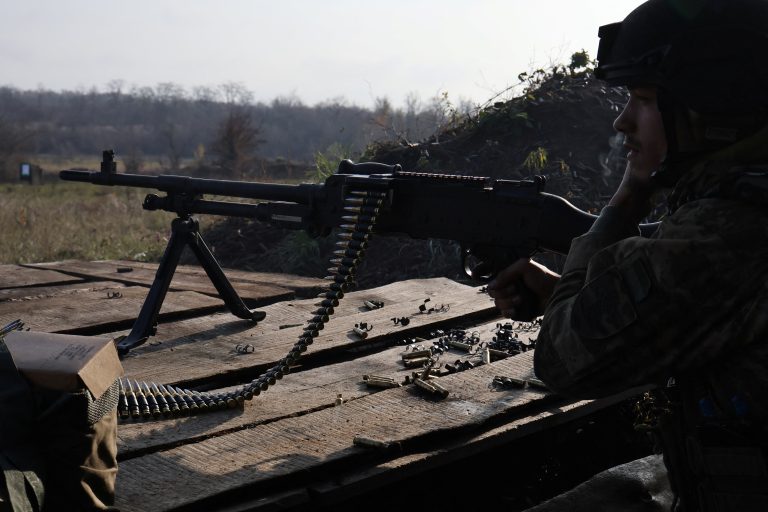On 16 November, the Kremlin announced that its forces had advanced rapidly in the Zaporizhzhya region and captured two settlements in a major offensive aimed at seizing the entire Zaporizhzhya region.
Ukraine, which has a smaller army than Russia, is now grappling with how to strengthen its defences near Pokrovsk in the Donetsk region while holding the rest of the front, which is subject to intense artillery and drone attacks as well as the advance of live fire by highly mobile Russian troops.
In Zaporizhzhya Oblast, a small part of which is separated from the occupied remnant by the Dnieper River, fighting intensified during the second week of November. Ukrainian troops finally withdrew from their positions near the villages of Novouspenivske, Nove, Ochotnytsia, Uspenivka and Novomykolajivka on 11 November.
This was due to the heavy Russian artillery fire - more than 400 artillery barrages a day, using about two thousand pieces of ammunition. Since the Ukrainian forces had no way to silence the Russian batteries, staying in position would have resulted in unsustainable losses of manpower to the defenders.
Since Russian forces entered the Dnepropetrovsk region in late June, they have been advancing there as they have in the neighboring Zaporizhzhya region, where they have advanced at least 30 kilometers along a fairly wide stretch of the front over the past six weeks, according to the Ukrainian website DeepState.
The Russian Ministry of Defence said on 16 November that its forces had captured Rivne-Pillya, putting Hulyai Pole at risk of becoming the target of a Russian pincer attack. Russian forces have also captured Mala Tokmachka, located just nine kilometres from Orichivo, which, along with the town of Hulyapole, is strategically important.
Michael Kofman, a military analyst at the US-based Institute for the Study of War (ISW), said that although the focus is on Pokrovsk, much of the Russian advance has taken place "further southwest, on the borders of Zaporizhzhya, Dnepropetrovsk and Donetsk regions, and has accelerated in recent weeks."
He also noted that Russian troops continue to "fall behind tactically" due to some troops "stubbornly claiming to occupy positions and advancements that never actually happened."
Some analysts, on the contrary, suggest that there is a deceptive push on the part of the Russian military in an attempt to force Ukraine to shift resources to the Zaporizhzhya region, thereby diverting them away from Pokrovsk.
The situation is changing rapidly
"In the current circumstances and without global changes not only at the level of the military command, but also in the political approach to defensive warfare, it is only a matter of time before Russian tanks invade the cities of Zaporizhzhya or the Dnieper," Serhiy Sternenko, a well-known Ukrainian military blogger, wrote on the social network, adding that he was struck by the silence surrounding the "crumbling defences".
Julian Röpcke, editor of the German daily Bild, said on the social network that the situation of the Ukrainian armed forces in the southeast of the country, as well as in the Kharkiv and Donbas areas, is changing rapidly and getting progressively worse.
"Neither the PR actions of the Ukrainian General Staff, nor the concealment or downplaying by the government in Kiev can hide the situation anymore," Röpcke wrote, adding that Ukraine is heading for a strategic defeat.
The numbers won't let up
Containing the Russian advance on the Zaporizhzhya front is crucial to protecting the Zaporizhzhya region's capital itself. However, the Russian offensive was launched after Kiev moved some of its forces to the northern part of the front, where Pokrovsk is expected to fall early.
Olexandr Syrskyi, Ukraine's chief of general staff, admitted that the situation in the Zaporizhzhya region had since "deteriorated significantly". At the same time, despite the redeployment of reinforcements, Russia is slowly advancing in the Myrnohrad and Pokrovsk areas, which are partly under siege and partly in a grey zone.
Because of the long-term, gradually deepening shortage of troops in the Ukrainian army, its command is facing criticism for not withdrawing troops from the Pokrovsk area and, instead of consolidating a new line of defence, defending a town that is likely to come under occupation one way or another.
Russia, on the other hand, thanks to its larger population and its monetarily attractive recruitment of contractors from home and abroad, is not suffering from a shortage of manpower. Moreover, the Kremlin has proceeded to the covert mobilisation of Ukrainians in the occupied Luhansk region, who will have to reinforce Russian forces on the front line.
